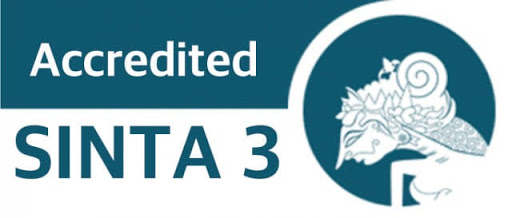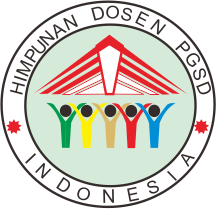BIBLIOMETRICS ANALYSIS AND MAPPING: THE TREND OF ‘ LEARNING METHOD” IN 2012-2022
Abstract
This research explained the phases of the systematic process the Learning Method . This research is initiated with an article search through keyword of learning method in the Scopus database across 2012-2022 period which resulted 130 articles. Using descriptive analysis and processed-visualized data with the help of VOSviewer software, this study shows the three-dominant concepts that are mostly studied, they are learning method, learning, and method. This research contributes to show the development and urgency of learning method. Meanwhile, the limitation is that the articles reviewed were only sourced from Scopus. Therefore, this study suggests that future studies require the use of a comparative analysis approach by implementing the Web of Science (WoS) database and increases the duration of the latest article search period especially learning method.
Keywords
Full Text:
PDF (ENGLISH)References
Agarwal, S., and D. Roth. 2002. “Learning a Sparse Representation for Object Detection.” doi: 10.1007/3-540-47979-1_8.
Akyol, Zehra, and D. Garrison. 2008. “The Development of a Community of Inquiry over Time in an Online Course: Understanding the Progression and Integration of Social, Cognitive and Teaching Presence.” Journal of Asynchronous Learning Networks 12:3–22. doi: 10.24059/OLJ.V12I3.66.
Akyol, Zehra, D. Garrison, and M. Ozden. 2009. “Development of a Community of Inquiry in Online and Blended Learning Contexts.” Procedia - Social and Behavioral Sciences 1:1834–38. doi: 10.1016/J.SBSPRO.2009.01.324.
Akyol, Zehra, D. Garrison, and M. Ozden. 2009. “Online and Blended Communities of Inquiry: Exploring the Developmental and Perceptional Differences.” The International Review of Research in Open and Distributed Learning 10:65–83. doi: 10.19173/IRRODL.V10I6.765.
Alavi, S. M., and M. Taghizadeh. 2013. “Cognitive Presence in A Virtual Learning Community: An EFL Case.” International Journal of E-Learning and Distance Education 27:1.
Annand, David. 2011. “Social Presence within the Community of Inquiry Framework.” The International Review of Research in Open and Distributed Learning 12:40–56. doi: 10.19173/IRRODL.V12I5.924.
Arbaugh, J., A. Bangert, and M. Cleveland-Innes. 2010. “Subject Matter Effects and the Community of Inquiry (CoI) Framework: An Exploratory Study.” Internet High. Educ. 13:37–44. doi: 10.1016/J.IHEDUC.2009.10.006.
Arbaugh, J., and Raquel Benbunan-Finch. 2006. “An Investigation of Epistemological and Social Dimensions of Teaching in Online Learning Environments.” Academy of Management Learning and Education 5:435–47. doi: 10.5465/AMLE.2006.23473204.
Arbaugh, J., and B. Rau. 2007. “A Study of Disciplinary, Structural, and Behavioral Effects on Course Outcomes in Online MBA Courses.” Decision Sciences Journal of Innovative Education 5:65–95. doi: 10.1111/J.1540-4609.2007.00128.X.
Diaz, S., Karen Swan, P. Ice, and L. Kupczynski. 2010. “Student Ratings of the Importance of Survey Items, Multiplicative Factor Analysis, and the Validity of the Community of Inquiry Survey.” Internet High. Educ. 13:22–30. doi: 10.1016/J.IHEDUC.2009.11.004.
Duggan, S. 1996. “Education, Teacher Training and Prospects for Economic Recovery in Cambodia.” doi: 10.1080/03050069628768.
Fergus, R., P. Perona, and Andrew Zisserman. 2003. “Object Class Recognition by Unsupervised Scale-Invariant Learning.” 2003 IEEE Computer Society Conference on Computer Vision and Pattern Recognition, 2003. Proceedings. 2:II–II. doi: 10.1109/CVPR.2003.1211479.
Garrison, D., T. Anderson, and R. Garrison. 2003. “E-Learning in the 21st Century: A Framework for Research and Practice.” doi: 10.4324/9780203166093.
Holmes, E., R. O’Connor, V. Perry, I. Tracey, S. Wessely, L. Arseneault, C. Ballard, H. Christensen, Roxane Cohen Silver, I. Everall, T. Ford, A. John, T. Kabir, Kate King, I. Madan, S. Michie, Andrew K. Przybylski, R. Shafran, A. Sweeney, C. Worthman, L. Yardley, K. Cowan, C. Cope, M. Hotopf, and E. Bullmore. 2020. “Multidisciplinary Research Priorities for the COVID-19 Pandemic: A Call for Action for Mental Health Science.” doi: 10.1016/S2215-0366(20)30168-1.
Kadiyono, A., Rezki Ashriyana Sulistiobudi, I. Haris, Mohd Hanif Abdul Wahab, I. Ramdani, A. Purwanto, A. Mufid, Muhammad Rikza Muqtada, M. Gufron, Mohamad Nuryansah, Lina Aris Ficayuma, M. Fahlevi, and Susila Sumartiningsih. 2020. “Develop Leadership Style Model for Indonesian Teachers Performance in Education 4.0 Era.” Systematic Reviews in Pharmacy 11:363–73.
Kumar, Swapna, K. Dawson, E. Black, Cathy Cavanaugh, and Christopher D. Sessums. 2011. “Applying the Community of Inquiry Framework to an Online Professional Practice Doctoral Program.” The International Review of Research in Open and Distributed Learning 12:126–42. doi: 10.19173/IRRODL.V12I6.978.
Lowe, D. 1999. “Object Recognition from Local Scale-Invariant Features.” Proceedings of the Seventh IEEE International Conference on Computer Vision 2:1150–57 vol.2. doi: 10.1109/ICCV.1999.790410.
Osuna, E., R. Freund, and F. Girosi. 1997. “Training Support Vector Machines: An Application to Face Detection.” Proceedings of IEEE Computer Society Conference on Computer Vision and Pattern Recognition 130–36. doi: 10.1109/CVPR.1997.609310.
Rourke, L., T. Anderson, D. Garrison, and W. Archer. 2007. “Methodological Issues in the Content Analysis of Computer Conference Transcripts.”
Rowley, H., S. Baluja, and T. Kanade. 1998. “Neural Network-Based Face Detection.” IEEE Trans. Pattern Anal. Mach. Intell. 20:23–38. doi: 10.1109/34.655647.
Supriadi, Oding, Zulkifli Musthan, Sa’odah, Rizki Nurjehan, Y. Haryanti, M. R. Marwal, A. Purwanto, A. Mufid, Rohmad Adi Yulianto, Moh Farhan, A. Fitri, M. Fahlevi, and Susila Sumartiningsih. 2020. “Did Transformational, Transactional Leadership Style and Organizational Learning Influence Innovation Capabilities of School Teachers during Covid-19 Pandemic?” Systematic Reviews in Pharmacy 11:299–311. doi: 10.31838/SRP.2020.9.47.
Vaillant, Régis, C. Monrocq, and Y. L. Cun. 1994. “Original Approach for the Localisation of Objects in Images.” doi: 10.1049/IP-VIS:19941301.
Viola, Paul A., and Michael J. Jones. 2001. “Rapid Object Detection Using a Boosted Cascade of Simple Features.” Proceedings of the 2001 IEEE Computer Society Conference on Computer Vision and Pattern Recognition. CVPR 2001 1:I–I. doi: 10.1109/CVPR.2001.990517.
Weber, Markus, M. Welling, and P. Perona. 2000. “Unsupervised Learning of Models for Recognition.” doi: 10.1007/3-540-45054-8_2.
DOI: http://dx.doi.org/10.33578/pjr.v7i1.8824
Refbacks
- There are currently no refbacks.
Copyright (c) 2023 JURNAL PAJAR (Pendidikan dan Pengajaran)

This work is licensed under a Creative Commons Attribution-NonCommercial-ShareAlike 4.0 International License.
JURNAL PAJAR (Pendidikan dan Pengajaran)
Secretariat
Program Studi Pendidikan Guru Sekolah Dasar
Gedung B1, FKIP Universitas Riau
Kampus Bina Widya Km. 12,5 Simpang Baru Panam
Pekanbaru Riau Indonesia 28293
e-mail : pajar@ejournal.unri.ac.id



